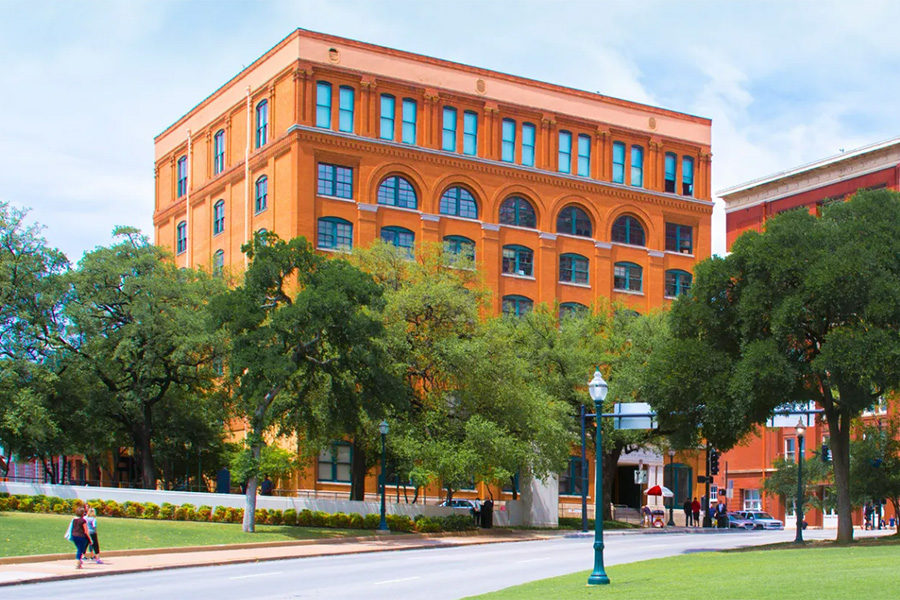The Six Floor Museum at Dealey Plaza

It was 60 years ago this month—Nov. 22 to be exact—that America and the world were changed in deep and irrevocable ways when President John F. Kennedy was assassinated as his motorcade passed by what was then the Texas School Book Depository in Dallas.
A variety of happenstances and situations that followed Kennedy’s death—among them the escalation of the Vietnam War and the ignition of Beatlemania and its subsequent effects on popular culture--have been attributed to the murder of the 35th president. And the “whodunit” aspect of the crime remains the nation’s most enduring unsolved mystery, as relatively few Americans today accept the government’s still-official determination that Lee Harvey Oswald acted alone.
As such, a visit to what is now the Dallas County Administration Building is particularly relevant as the milestone anniversary is reached; the historic, seven-story structure currently houses the The Sixth Floor Museum at Dealey Plaza.
Located on the very floor from which Oswald is believed to have fired three shots with his mail-order rifle, the museum provides visitors not only with a number of fascinating assassination-related photographs, documents and items, but with a visual perspective no photo or film clip can match.
Perhaps the most interesting aspect of the repository is that it is unabashedly low-tech. Encompassing but a single, low-ceilinged room, there is none of the cutting-edge, digital enhancements so many museums offer. But that hardly detracts from the space’s drama and impact.
As one begins the self-guided tour, the first stop is an area that details the pop culture landscape that existed in November, 1963. Such avatars of the era as Chubby Checker and “The Twist” and the iconic Alfred Hitchcock film “Psycho” set the stage for what is to come.
Next is a display that recounts Kennedy’s 1960 presidential campaign, as well as other aspects of his personal and political lives. That leads into a look (utilizing video and audio recordings) at the assassination itself beginning with a recounting of his arrival in Texas (complete with coverage of the rabid and highly public anti-Kennedy activities that occurred prior to his trip) and his landing at Dallas’ Love Field airport on the morning of the 22nd.
In addition to a small video screening area, the museum also boasts numerous items, some of which are truly iconic. Among them are the suit and Stetson hat worn by Det. James R. Leavelle, who was handcuffed to Oswald when he was shot and killed by nightclub owner Jack Ruby on Nov. 25, 1963, and the hat Ruby wore that day.
The various investigations into the assassination are also documented. However, no conclusions are drawn; visitors are left to decide for themselves whether Oswald acted alone or was part of a conspiracy.
The wall that fronts Dealey Plaza is lined with seven large windows. Oswald was perched at the one on the far left (as seen from inside). This window—and his sniper’s nest—today sits off-limits behind a glass wall. Using archival photographs, the space has been painstakingly duplicated with boxes stacked and arranged exactly as they were on that fateful day.
While the public cannot share Oswald’s exact view, an accessible window is just a couple feet away, affording visitors a pretty accurate facsimile of what Oswald saw as Kennedy’s limousine made that now-famous left turn from Houston Street onto Elm Street, which runs along the building’s front.
For this assassination buff, looking out that window—which also provides a panoramic view of Dealey Plaza including the “grassy knoll” from which many believe the shot that actually killed JFK was fired—was a most profound experience. Despite seeing countless photos and film clips and watching numerous documentaries, for the first time I was able to fully comprehend the lay of the land on that sunny autumn afternoon in the “Big D.”
And it was somewhat overwhelming to contemplate the events of that day while gazing at the exact spot they took place from as close to Oswald’s vantage point as one can get.
In America, there are bigger museums, more technologically elaborate museums and those which are more architecturally impressive. But in terms of historic significance and emotional resonance, The Sixth Floor Museum at Dealey Plaza definitely stands at or near the top of the list.
For museum information visit:




